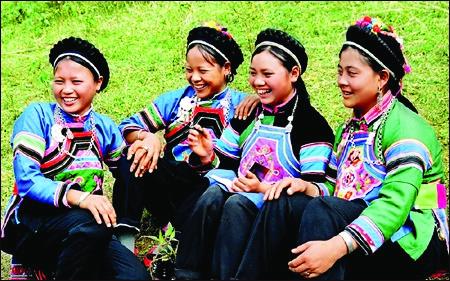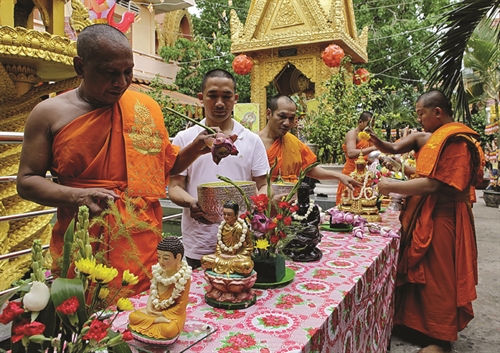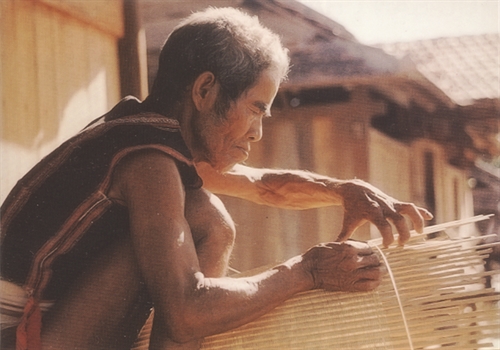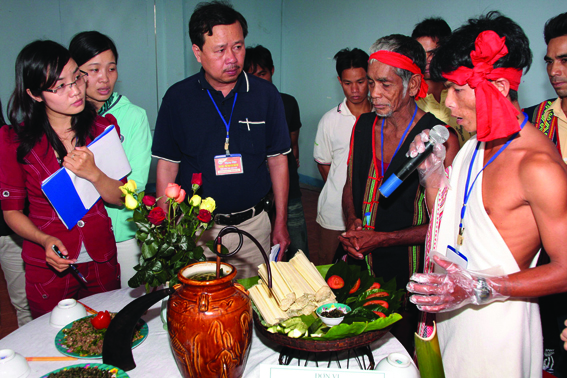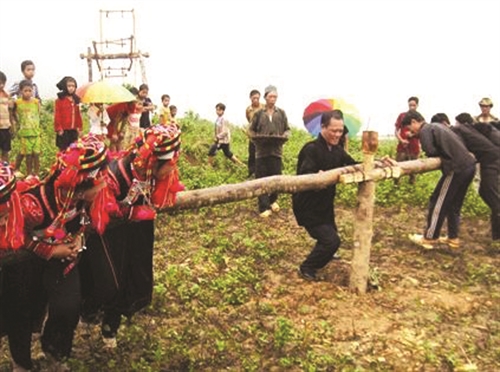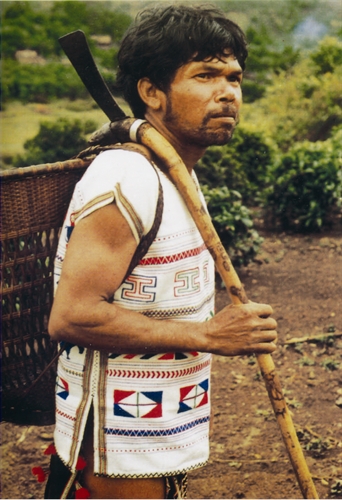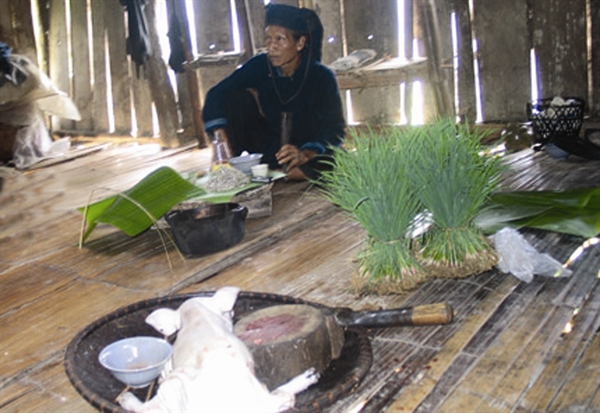Doctor NGUYEN THI HUONG LIEN
Folk Culture Institute
The Vietnamese celebrate the Doan Ngo (also called Doan Duong) festival on the 5th day of the 5th lunar month - this year, the Doan Ngo festival falls on June 9. This is an important festive occasion in the year, second only to the Nguyen Dan (Lunar New Year) festival. Tribute of students to their teachers and of sons-in-law to their parents-in-law is mostly paid on these two major occasions.
What stands the Doan Ngo festival out is that it is not just an occasion for festivities, but is also considered a propitious occasion to cure diseases. The festival is held at the beginning of the summer time, which is also the season for the prolification of many diseases caused by insects and worms, especially mosquitoes and flies. In the old days, the role of these germ-carrying agents escaped the knowledge of man, who could only notice the coincidence of the appearance of numerous kinds of insects and the outbreak of epidemics, such as dysentery, cholera, malaria, influenza, etc. Hence, Doan Ngo was considered the best time for a campaign of mass extermination of insects and germs. That is why, the Doan Ngo festival is also commonly known as "insect killing festival". Today, with the development of science, especially biology and epidemiology, the origins of most diseases have been brought to light and the old belief in the curative power of the rituals has lost most of its weight. Still, people continue to celebrate the Doan Ngo festival.
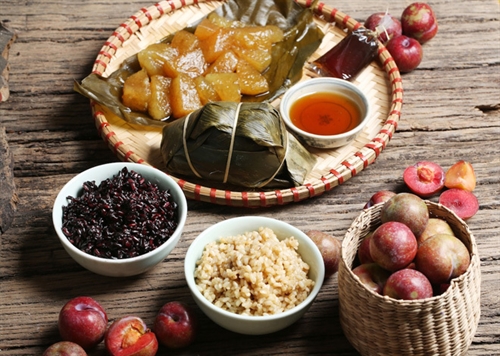 |
| Traditional foods, including fermented rice, rice cake and plum, in Doan Ngo festival__Photo: Internet |
By tradition, several days before the festival, all families prepared a large pot of fermented rice together with a dozen fresh eggs and a variety of fruit which in this case consist chiefly of water melons, peaches and plums. A rice cake to be eaten with sweetened sorghum was also indispensable. Those with small children would buy amulets made of plaited multi-colored threads or embroidered figures of flowers, a hot pepper pod, a carambola or a peach which would be worn by the kids on the festive day. Many families also made new silk clothes which they took to the pagoda where the monk would have a cryptic figure drawn on it to serve as a talisman against evil spirits or as a blessing for the child to stay in good health. Most characteristic is the custom of dyeing the finger and toe nails of the children on the eve of the festival. The dyeing material is made by crushing a kind of red flower to which a few drops of lemon juice were added. The crushed flower petals were placed on the nails and tied with a leaf of the coral tree which would be removed early the next morning. But the forefingers and the fore toes were not dyed, nobody knows why. Early on the 5th day of the 5th lunar month, the adults woke the children very early and fed them immediately with the fermented rice, boiled eggs, sorghum rice cakes and fruits allegedly to kill the insects. It was widely believed that these foods would expel all the worms from the child's intestines and prevent the invasion of all other diseases. Then they took a bottle of alcohol mixed with "hung hoang", a concoction color yellow, and applied it to the top of the crown, sternum and navel of the child which are believed to be the main entrances of diseases into the body.
"Hung hoang" is a mineral of the sulphur type used chiefly as dye, but also as an ingredient in a number of oriental medicine recipes. Only then were the children allowed to wash their faces and wear the amulets, change their clothes and remove the coral tree leaves on their finger and toe nails.
The nails took a rosy color after the dyeing and this color is said to be a repellent against all noxious elements. That is for the boys. As for the girls, the Doan Ngo festival is also the occasion to pierce their ear lobes because, again according to popular belief, the Adults "killed" the insects by drinking rice alcohol mixed with "hung hoang" and also ate boiled eggs. In many localities, there were cakes to go with the alcohol before fruits were served.
The worshipping ceremony for the ancestors was held at the "ngo" hour (the hour of the Horse) which in oriental time-keeping lasts from 11 o'clock till 13 o'clock. As the worshipping ceremony took place, some members in the family went out to pick various kinds of innocuous leaves in the garden or nearly forests, which would be left to dry in the sun and used later as medicine for the whole year. Usually, these leaves are known medicinal herbs, such as absinth, balm mint, sweet marjoram, dandelion, citronella or the leaves of orange, tangerine, bamboo, guava trees, etc. The best collection would comprise exactly one hundred kinds of leaf. The leaf picking is also an occasion for all members in the family to make an outing and vie with one another in the sense of discernment when deciding to pick this and not that leaf. Another custom consisted in using the leaves of absinth and other medicinal leaves to make figures of the animals in the oriental zodiac such as the Cat, the Monkey, the Tiger, the Dragon, etc. according to the years bearing their names. These scare-crows were hung outside the main entrance door of the house, and later preserved as medicine for the whole year.
Chinese books also record the traditional Doan Ngo festival held on the same day as in Vietnam but with a completely different origin. It is the anniversary of the death of Qu Yuan, a high mandarin of the Chu state (340-278 BC) in the times of the Warring States period in ancient China. As a great poet and erudite, Qu Yuan tried in vain to dissuade the king from adopting unpopular policies. He retired and wrote his masterpiece "Li Sao" (Encountering Sorrow) then drowned himself in the Miluo river in today's Hunan province on the 5th day of the 5th month of the lunar year (278 BC). He was deeply regretted by the Chinese people who observed his death as a memorial day which later became a festival. On that day people went to the Miluo river and held a boat race symbolizing the retrieval of his body and dropped small rice cakes into the river. The cake was wrapped in leaves and tied with multi-colored threads out of the belief that they would scare the fish away.

